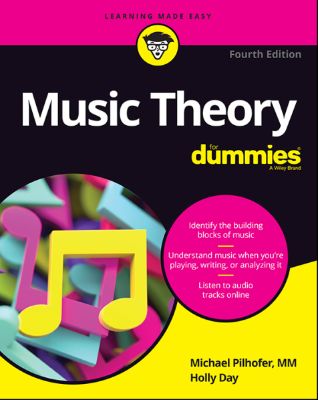
Lýsing:
Tune in to how music really works Whether you’re a student, a performer, or simply a fan, this book makes music theory easy, providing you with a friendly guide to the concepts, artistry, and technical mastery that underlie the production of great music. You’ll quickly become fluent in the fundamentals of knocking out beats, reading scores, and anticipating where a piece should go, giving you a deeper perspective on the works of others -- and bringing an extra dimension to your own.
Tracking to a typical college-level course, Music Theory For Dummies breaks difficult concepts down to manageable chunks and takes into account every aspect of musical production and appreciation -- from the fundamentals of notes and scales to the complexities of expression and instrument tone color. It also examines the latest teaching techniques -- all the more important as the study of music, now shown to provide cognitive and learning benefits for both children and adults, becomes more prevalent at all levels.
Master major and minor scales, intervals, pitches, and clefs Understand basic notation, time signals, tempo, dynamics, and navigation Employ melodies, chords, progressions, and phrases to form music Compose harmonies and accompanying melodies for voice and instruments Wherever you want to go musically -- as a writer or performer, or just as someone who wants to enjoy music to its fullest -- this approachable guide gives you everything you need to hear!.
Annað
- Höfundar: Michael Pilhofer, Holly Day
- Útgáfa:4
- Útgáfudagur: 2019-06-14
- Hægt að prenta út 10 bls.
- Hægt að afrita 2 bls.
- Format:ePub
- ISBN 13: 9781119575511
- Print ISBN: 9781119575528
- ISBN 10: 1119575516
Efnisyfirlit
- Cover
- Introduction
- About This Book
- Foolish Assumptions
- Icons Used in This Book
- Beyond the Book
- Where to Go from Here
- Part 1: Getting Started with Music Theory
- Chapter 1: What Is Music Theory, Anyway?
- Unearthing Music Theory’s Beginnings
- Putting the Spotlight on Music Theory Fundamentals
- Seeing How Theory Can Help Your Music
- Chapter 2: Determining What Notes Are Worth
- Meeting the Beat
- Recognizing Notes and Note Values
- Checking Out Whole (Semibreve) Notes
- Homing in on Half (Minim) Notes
- Considering Quarter (Crotchet) Notes
- Examining Eighth (Quaver) Notes and Beyond
- Extending Notes with Dots and Ties
- Mixing All the Note Values Together
- Chapter 3: Giving It a Rest
- Getting to Know the Rests
- Extending the Break with Dotted Rests
- Practicing Beats with Notes and Rests
- Chapter 4: Introducing Time Signatures
- Decoding Time Signatures and Measures
- Keeping Things Easy with Simple Time Signatures
- Working with Compound Time Signatures
- Feeling the Pulse of Asymmetrical Time Signatures
- A Short Discussion about Conducting
- Chapter 5: Playing with Beat
- Creating Stress Patterns and Syncopation
- Getting a Jump on Pick-Up Notes
- Exploring Irregular Rhythms: Triplets and Duplets
- Chapter 1: What Is Music Theory, Anyway?
- Chapter 6: Music Notes (and Where to Find Them)
- Meeting the Staff, Clefs, and Notes
- Identifying Half Steps, Whole Steps, and Accidentals
- Finding the Notes on the Piano and the Guitar
- Using Mnemonics to Help Remember Notes
- Chapter 7: Mastering the Major and Minor Scales
- Following Major-Scale Patterns
- Discovering All That Minor Scale Patterns Have to Offer
- Chapter 8: Key Signatures and the Circle of Fifths
- Understanding the Circle of Fifths and Recognizing Major Key Signatures
- Finding Minor Key Signatures and Relative Minors
- Visualizing the Key Signatures
- Chapter 9: Intervals: The Distance between Pitches
- Breaking Down Harmonic and Melodic Intervals
- Looking at Unisons, Octaves, Fourths, and Fifths
- Recognizing Seconds, Thirds, Sixths, and Sevenths
- Building Intervals
- Showing Major and Perfect Intervals in the C Major Scale
- Checking Out Compound Intervals
- The Nashville Number System
- Chapter 10: Chord Building
- Creating Triads with Three Pitches
- Expanding to Seventh Chords
- Looking at All the Triads and Sevenths
- Manipulating Triads through Voicing and Inversion
- Exploring Extended Chords
- Chapter 11: Chord Progressions
- Reviewing Diatonic Chords, Chromatic Chords, and Minor Scale Modes
- Identifying and Naming Chord Progressions
- Adding a Seventh Chord to a Triad
- Seeing (and Hearing) Chord Progressions in Action
- Applying Chord Knowledge to Fake Books and Tabs
- Modulating to a New Key
- Reaching a Musical Cadence through Chord Progressions
- Chapter 12: Creating Varied Sound through Tempo and Dynamics
- Taking the Tempo of Music
- Dealing with Dynamics: Loud and Soft
- Chapter 13: Instrument Tone Color and Acoustics
- Delving into Tone Color
- Building the Band: An Acoustics Lesson
- Chapter 14: The Building Blocks of Music: Rhythm, Melody, Harmony, and Song Form
- Establishing Rhythm
- Shaping the Melody
- Complementing the Melody with Harmony
- Working with Musical Phrases and Periods
- Linking Musical Parts to Create Forms
- Chapter 15: Relying on Classical Forms
- Counterpoint as a Classical Revelation
- Sussing Out the Sonata
- Rounding Up the Rondo
- Figuring Out the Fugue
- Combining Forms into a Symphony
- Observing Other Classical Forms
- Chapter 16: Tapping into Popular Genres and Forms
- Feeling the Blues
- Having Fun with Rock and Pop
- Improvising with Jazz
- Twelve-Tone Compositions
- Chapter 17: Ten Frequently Asked Questions about Music Theory
- Why Is Music Theory Important?
- If I Can Already Play Some Music, Why Bother Learning Music Theory?
- Why Is So Much Music Theory Centered on the Piano Keyboard?
- Is There a Quick and Easy Way to Learn to Read Music?
- How Do I Identify a Key Based on the Key Signature?
- Can I Transpose a Piece of Music into Another Key?
- Will Learning Music Theory Hinder My Ability to Improvise?
- Do I Need to Know Theory if I Just Play Drums?
- Where Do the 12 Musical Notes Come From?
- How Does Knowing Theory Help Me Memorize a Piece of Music?
- Chapter 18: Ten Keys to Reading a Musical Score
- The Basics
- Lead Sheets
- Full Scores
- Miniature Scores
- Study Scores
- Piano Scores
- Short Scores
- Vocal Scores
- Tablature
- Figured Bass Notion
- Chapter 19: Ten Music Theorists You Should Know About
- Pythagoras (582–507 BC)
- Boethius (480–524 AD)
- Gerbert d’Aurillac/Pope Sylvester II (950–1003)
- Guido D’Arezzo (990–1040)
- Nicola Vicentino (1511–1576)
- Christiaan Huygens (1629–1695)
- Arnold Schoenberg (1874–1951)
- Harry Partch (1901–1974)
- Karlheinz Stockhausen (1928–2007)
- Robert Moog (1934–2005)
- Chapter 20: Ten Musical Movements That Changed History
- 800 AD — England, Gregorian Chant
- 1100 AD — Organum/European Polyphony
- 1649 — England, the Diggers
- 17th Century: Italy, Opera
- 1789-1799: The French Revolution
- 1913 — Atonal Music and Igor Stravinsky’s “The Rite of Spring”
- 1950-1990: Latin America and the Iberian Peninsula, “Nueva Canción” (the New Song Movement)
- 1960s: U.S. Civil Rights Movement
- 1980s: Estonia Singing Revolution
- 2010-2012: Arab Spring
- Appendix A: Audio Tracks
- Appendix B: Chord Chart
- Appendix C: Glossary
UM RAFBÆKUR Á HEIMKAUP.IS
Bókahillan þín er þitt svæði og þar eru bækurnar þínar geymdar. Þú kemst í bókahilluna þína hvar og hvenær sem er í tölvu eða snjalltæki. Einfalt og þægilegt!Rafbók til eignar
Rafbók til eignar þarf að hlaða niður á þau tæki sem þú vilt nota innan eins árs frá því bókin er keypt.
Þú kemst í bækurnar hvar sem er
Þú getur nálgast allar raf(skóla)bækurnar þínar á einu augabragði, hvar og hvenær sem er í bókahillunni þinni. Engin taska, enginn kyndill og ekkert vesen (hvað þá yfirvigt).
Auðvelt að fletta og leita
Þú getur flakkað milli síðna og kafla eins og þér hentar best og farið beint í ákveðna kafla úr efnisyfirlitinu. Í leitinni finnur þú orð, kafla eða síður í einum smelli.
Glósur og yfirstrikanir
Þú getur auðkennt textabrot með mismunandi litum og skrifað glósur að vild í rafbókina. Þú getur jafnvel séð glósur og yfirstrikanir hjá bekkjarsystkinum og kennara ef þeir leyfa það. Allt á einum stað.
Hvað viltu sjá? / Þú ræður hvernig síðan lítur út
Þú lagar síðuna að þínum þörfum. Stækkaðu eða minnkaðu myndir og texta með multi-level zoom til að sjá síðuna eins og þér hentar best í þínu námi.
Fleiri góðir kostir
- Þú getur prentað síður úr bókinni (innan þeirra marka sem útgefandinn setur)
- Möguleiki á tengingu við annað stafrænt og gagnvirkt efni, svo sem myndbönd eða spurningar úr efninu
- Auðvelt að afrita og líma efni/texta fyrir t.d. heimaverkefni eða ritgerðir
- Styður tækni sem hjálpar nemendum með sjón- eða heyrnarskerðingu
- Gerð : 208
- Höfundur : 10843
- Útgáfuár : 2019
- Leyfi : 379


